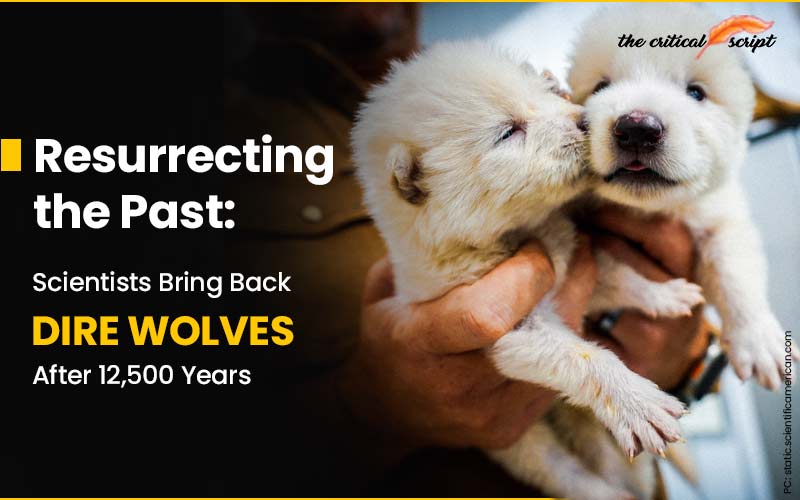
Resurrecting the Past: Scientists Bring Back Dire Wolves After 12,500 Years
In
what may become one of the most defining moments in modern genetic science, a
team of researchers at Colossal Biosciences has achieved what was once the
stuff of science fiction: the successful recreation of the dire wolf, Canisdirus, an apex predator that roamed
North America during the Pleistocene epoch before going extinct roughly 12,500
years ago.
Using
a remarkable combination of ancient DNA sequencing, CRISPR gene editing, and
cloning technology, scientists have produced three live dire wolf pups - two
males and one female - heralding a bold new chapter in de-extinction science.
The Science Behind the Resurrection
Often
romanticized as the larger, more fearsome cousin of the gray wolf, the dire
wolf has long fascinated paleontologists and pop culture enthusiasts alike.
However, genetic analysis over the last decade shattered that notion -
revealing that dire wolves represent a unique and distant lineage, diverging
from modern wolves nearly 5.7 million years ago.
To
resurrect the species’ defining traits, scientists sourced ancient DNA from
dire wolf fossils - including specimens from the famed La Brea Tar Pits. By
comparing these fragments with the modern gray wolf genome, they identified 14
critical genes responsible for traits such as:
●
Dense, insulating fur
suited for Ice Age climates
●
Robust skulls and
powerful jaws capable of bone-crushing
●
Broad chests and
muscular limbs designed for strength and endurance
These
genes were precisely edited into gray wolf DNA using CRISPR-Cas9 technology.
The resulting embryos were implanted into domestic dog surrogates - a practical
choice for gestation - and, after months of monitoring, three pups were born
between December 2024 and February 2025 in a secure research facility.
Though
genetically about 99.9% gray wolf, the pups exhibit the physical and behavioral
markers associated with dire wolves, marking the most sophisticated recreation
of an extinct species to date.
“This
is not just a cosmetic imitation,” said Dr. Eliza Harcourt, lead geneticist at
Colossal. “We’ve recreated a functional organism that mirrors the dire wolf’s
physiology and behavior. This is a working prototype of de-extinction in
action.”
A Controlled Rebirth
The
pups were transferred to a 2,000-acre protected reserve designed to mimic a
naturalistic environment, while maintaining strict biosecurity protocols. Here,
researchers hope to study their development, interaction, and ecological
behaviors in a semi-wild but controlled space.
Yet,
this landmark moment raises profound questions - not just about science and
possibility, but about ethics, ecology, and existential responsibility.
At the Ethical Crossroads of De-Extinction
The
idea of bringing back extinct species has long been romanticized, but now that
it is a tangible reality, the implications are more complex. With the revival
of dire wolves, we find ourselves at a scientific and moral crossroads.
Where Do We Draw the Line?
While
Colossal Biosciences has already announced plans to bring back other extinct
species - like the woolly mammoth, Tasmanian tiger, and dodo - the successful
birth of dire wolf pups opens doors to even bolder ambitions. Some researchers
have speculated about someday reviving species from the dinosaur era, despite
glaring genetic and ecological incompatibilities.
This
raises unsettling concerns:
●
Are we on the verge of
a real-life “Jurassic Park” scenario?
●
What happens if
recreated animals introduce new pathogens, or develop into invasive,
uncontrollable species?
●
Could these beings
cause ecological imbalances in already fragile environments?
Ecosystem Restoration or Disruption?
Advocates
claim that reintroducing extinct species could help restore lost ecological
functions. Yet ecosystems have evolved significantly since these species
disappeared. The world of the dire wolf is gone, replaced by modern biomes,
human development, and new interspecies dynamics.
Even
if such animals are confined to controlled environments, their very existence
sets a precedent that could be difficult to regulate - especially if private or
commercial entities start racing to revive more species.
Genetic Authenticity and the Illusion of Resurrection
Despite
media excitement, it’s important to clarify: these are not true dire wolves.
They are genetically modified gray wolves, carefully engineered to resemble
their extinct relatives in physical form and behavior - but not in full genetic
heritage.
This
blurs the line between revival and reinvention. We’re not resurrecting the past
- we’re rebuilding it in fragments, based on limited data and modern
assumptions. These animals are part dire wolf, part scientific interpretation,
and part laboratory construct.
Moral Dilemmas and Priorities
A
critical question looms: Are we bringing these creatures back for them - or for
ourselves?
Born
in sterile labs and raised in observation enclosures, these animals live lives
dictated entirely by human design. Is this a form of progress - or are we simply
building a living museum for scientific prestige?
Moreover,
many conservationists argue that the enormous funding required for
de-extinction could be better invested in saving endangered species still
struggling to survive. Shouldn’t we prevent extinction before we attempt to
reverse it?
Final Thought: A Future Worth Creating?
With
the successful birth of the dire wolf pups, fiction is now fact. But as we
cross this unprecedented threshold, we must ask: What kind of future are we
building?
Are
we becoming thoughtful stewards of a revived natural world - or reckless
creators meddling with powers we don’t fully understand?
Once
the door to de-extinction has opened, there may be no turning back. The
decision before us is not just about science - it’s about who we are, and how
we choose to live with the power to reshape life itself.
Disclaimer: The opinions expressed in this article are those of the author's. They do not purport to reflect the opinions or views of The Critical Script or its editor.

Newsletter!!!
Subscribe to our weekly Newsletter and stay tuned.

















Related Comments